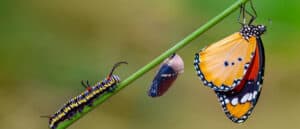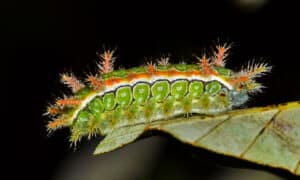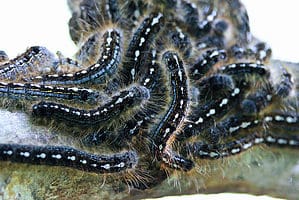In the lush landscapes of Tennessee, there is a diverse array of caterpillars that you can find munching on leaves, preparing to transform into stunning butterflies and moths. But did you know that among the numerous caterpillar species found in this region, a few possess toxins that can irritate the skin or, in rare cases, pose a more serious threat?
In this article, we’ll introduce you to the variety of caterpillars in Tennessee and highlight which ones you might want to keep a respectful distance from. Stay informed and enjoy the beauty of nature safely!
1. American Dagger Caterpillar (Acronicta americana)
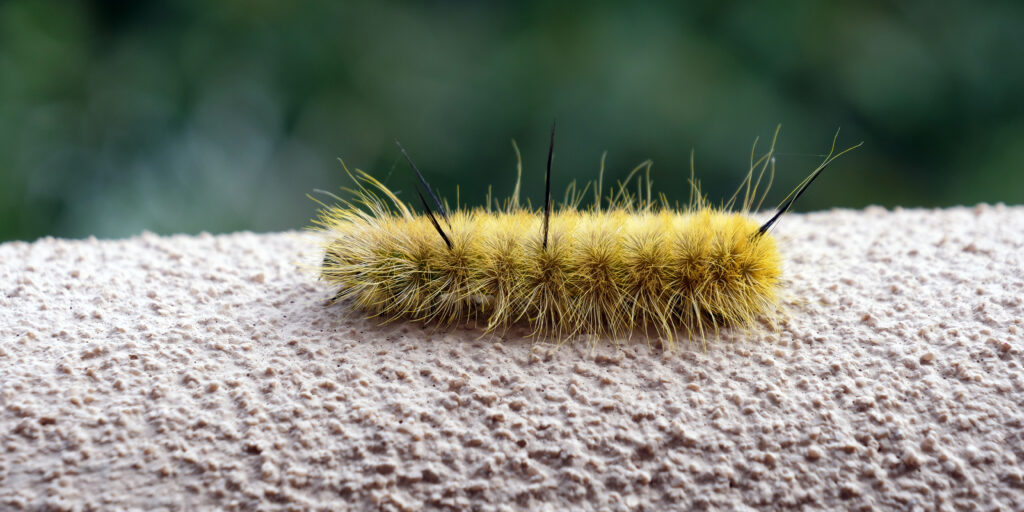
American dagger caterpillars contain venom that can lead to a rash and other symptoms.
©Martha Marks/Shutterstock.com
These caterpillars can grow up to 2 inches long and sport dense, white, or light yellow fur. At both ends, they have prominent black bristles. Their diet includes birch, alder, willow, elm, walnut, and other leaf-shedding trees.
While the American dagger caterpillar might look benign, they are, in fact, toxic. Their bristles contain a venom that, while not lethal, can lead to an agonizing rash and other symptoms. This discomfort arises due to an allergic response to their venom.
2. American Lappet Moth Caterpillar (Phyllodesma americana)
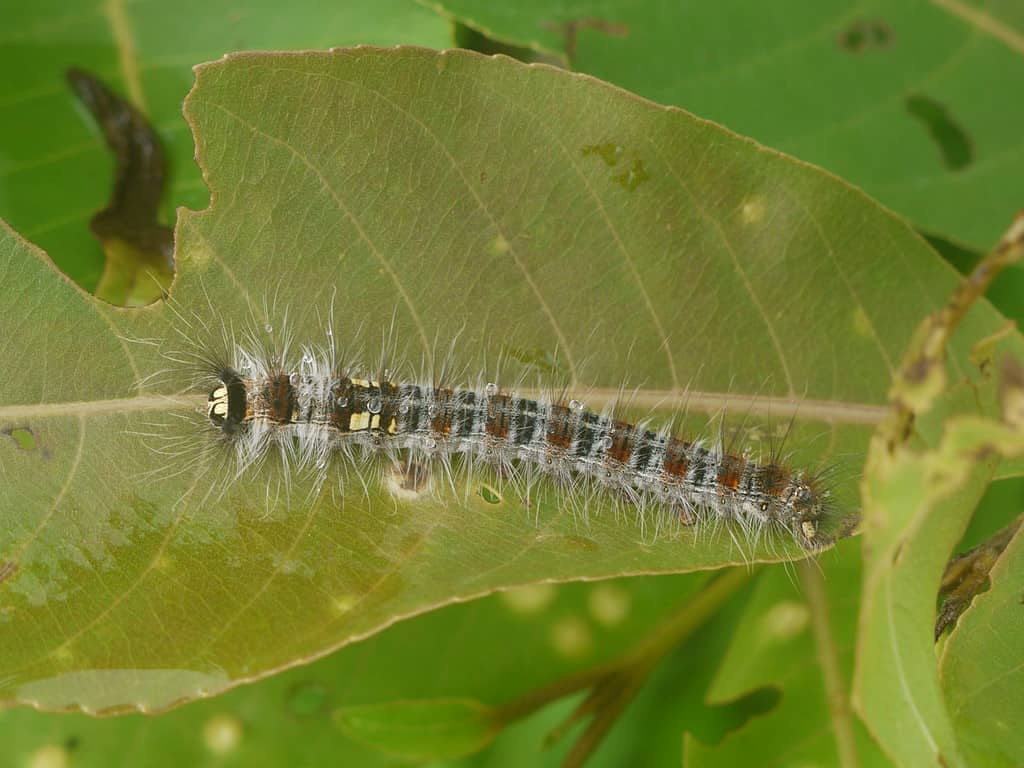
A hairy caterpillar, the American lappet moth carries a toxin.
©Dinesh Valke from Thane, India / CC BY-SA 2.0 – License
The American lappet moth caterpillar boasts hairy lobes along its sides. Its gray exterior sometimes reflects shades of green or blue. While some display an orange fringe near their legs, others have tiny orange spots on their upper side. The contrast between black and white patterns varies, with some appearing mostly black with white specks and others vice versa.
In response to danger, the caterpillar elongates its body, revealing two bright red, orange, or yellow stripes near its head, a characteristic that makes it easily identifiable. As for their diet, these caterpillars munch on willowherbs, fuchsia, and bedstraw, whereas the adult form prefers nectar.
Beware of the caterpillar’s hair, as it carries a toxin causing stinging and itching sensations.
3. Army Cutworm Caterpillar (Euxoa auxiliaris)
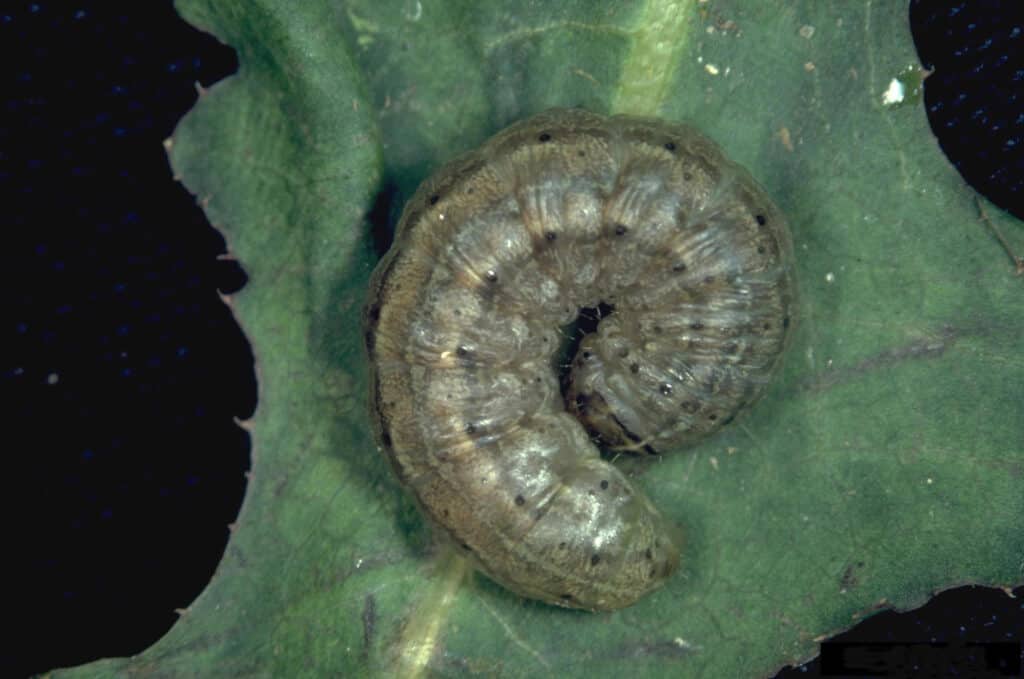
A caterpillar you can find in Tennessee is the army cutworm.
©Frank Peairs, Colorado State University, United States / CC BY 3.0 US – License
Army cutworm caterpillars, when fully grown, measure between 1½ to 2 inches. Their color ranges from green to black, with their upper side being darker than their underside. Similar to other cutworms, their diet is diverse. They consume a variety of crops like alfalfa, canola, corn, mustard, and wheat. Additionally, they munch on garden plants, several kinds of weeds, and grasses.
While the army cutworm moth is a frequent pest in the U.S. vegetable gardens, it’s not harmful to humans, though it can cause crop damage.
4. Buck Moth Caterpillar (Hemileuca maia)
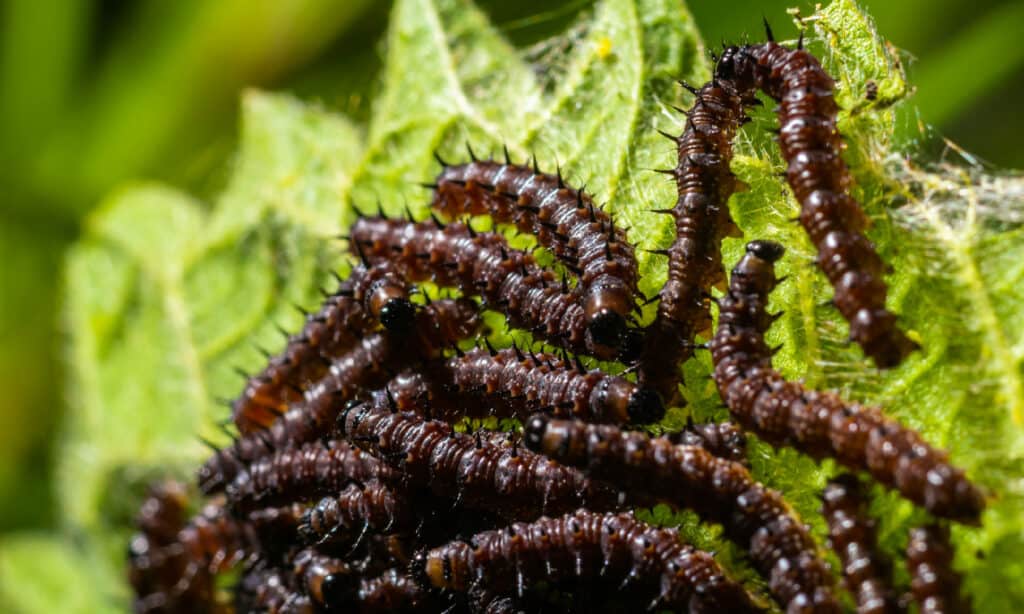
Be careful of buck moth caterpillars!
©iStock.com/Oleg Marchak
Buck moth caterpillars, when they reach their full size, measure around 2 inches. Their appearance is unique: while their head and legs can be anywhere from orange to a deep red or even black, their body is typically black and dotted with white specks. However, some might appear almost entirely white.
These caterpillars have a preference for oaks in their diet, feasting on varieties like scrub oak, blackjack oak, and dwarf chestnut oak.
You should be cautious around these caterpillars due to their venomous hairs or spines. These are hollow and are linked to poison-filled glands beneath. Touching them can lead to a stinging burn and swelling as intense as a bee’s sting.
5. Common Buckeye Caterpillar (Junonia coenia)
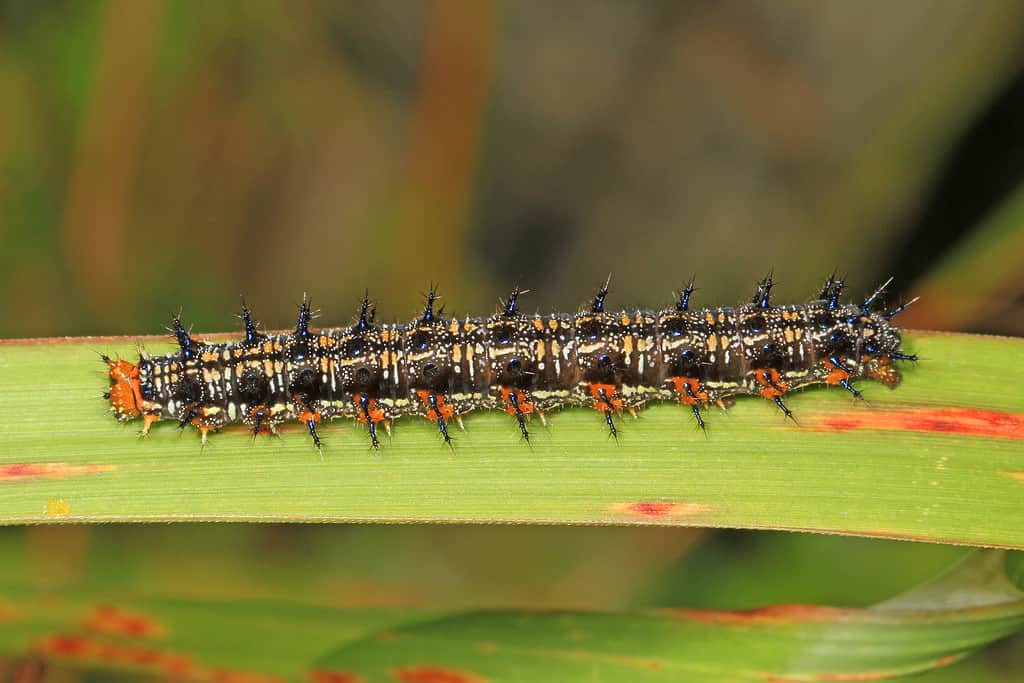
While they have spines, common buckeye caterpillars are safe.
©Judy Gallagher / CC BY 2.0 – License
Common buckeye caterpillars typically sport a bluish-black hue adorned with yellow to creamy orange lines and dots. They also have shiny bluish-black spines that are relatively short and branching. Interestingly, the spines on their sides spring from prominent orange bases. Their head contrasts with a black color but is topped with an orange crown.
Preferring solitude, these caterpillars mostly savor the leaves of the weed plantain and Gerardia, a plant known for its attractive blossoms.
While buckeye butterfly caterpillars do possess spines, they’re completely safe and won’t harm you.
6. Eastern Tent Caterpillar (Malacosoma americanum)
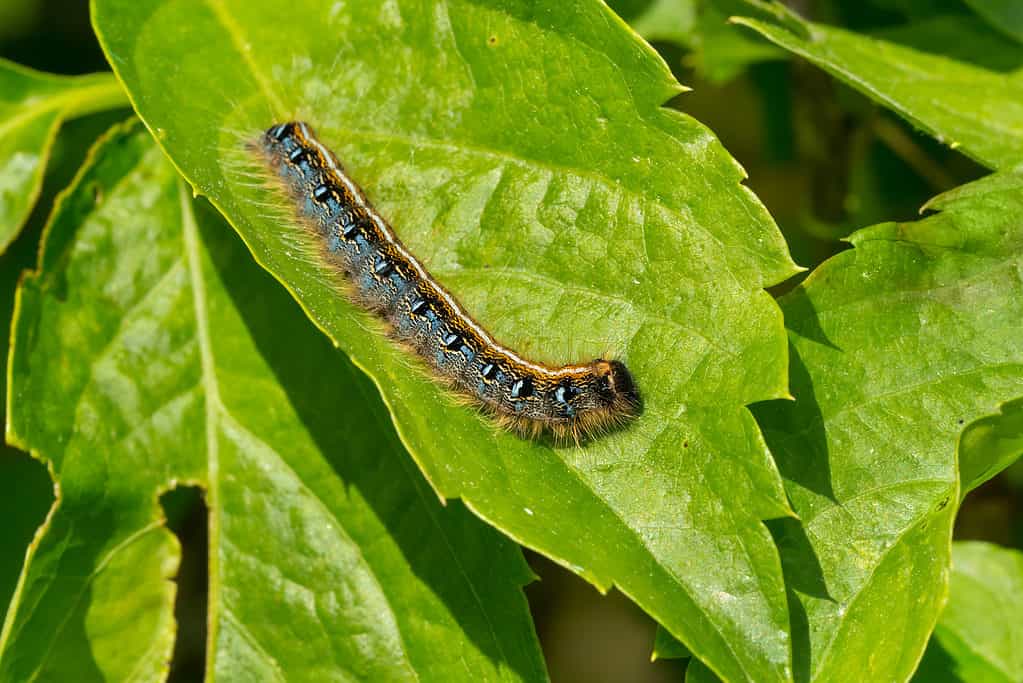
This hairy caterpillar eats wild cherry, apple, and crabapple trees in Tennessee.
©Paul Reeves Photography/Shutterstock.com
Eastern tent caterpillars have hairy bodies adorned with blue, black, and yellow-orange designs, highlighted by a distinctive white line running down their spine. Although their texture is predominantly smooth, a row of bristles line their sides. When they reach their full size, they measure about two inches.
Their preferred meals come from wild cherry, apple, and crabapple trees. However, they’re not picky and will also munch on leaves from ash, maple, oak, poplar, cherry, peach, and plum trees.
Contrary to some beliefs, eastern tent caterpillars pose no threat to humans.
7. Eastern Tiger Swallowtail Caterpillar (Papilio glaucus)
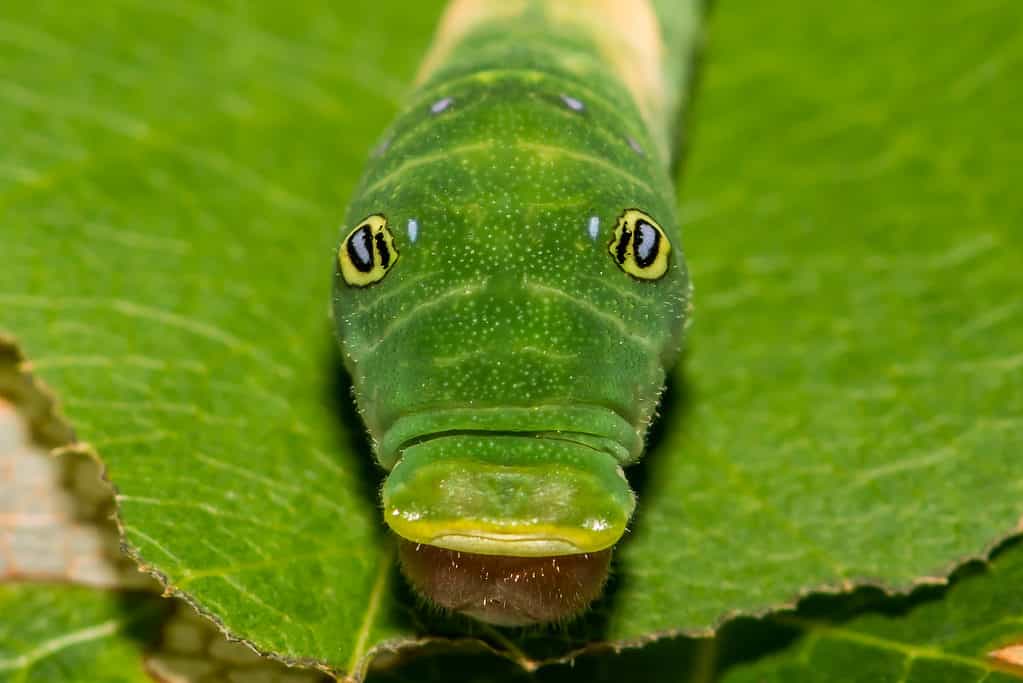
Another harmless caterpillar in Tennessee is the eastern
tiger
swallowtail.
©Jay Ondreicka/Shutterstock.com
Eastern tiger swallowtail caterpillars, in their early stages, bear a resemblance to bird droppings with their brown and white coloration. However, as they grow older, they take on a vibrant green shade and sport two impressive false eyespots in black, yellow, and blue, positioned just above and behind their real eyes.
These larvae have an appetite for the leaves of multiple woody plants, with favorites being wild cherry, birch, cottonwood, and willow.
Despite their fierce eating habits, these caterpillars are completely harmless and carry no toxins.
8. Fall Webworm Caterpillar (Hyphantria cunea)
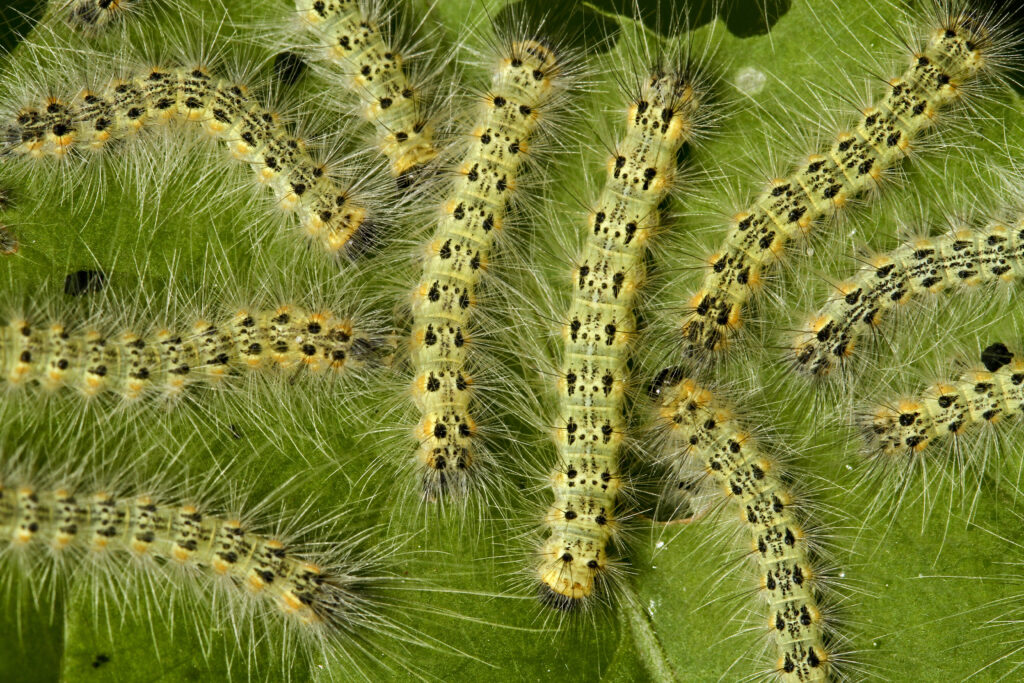
The fall webworm moth caterpillar creates its own unique webs.
©Geza Farkas/Shutterstock.com
Originating from North America, the fall webworm can be found in a large portion of the U.S., including places like Tennessee. Their appearance is diverse, with colors spanning from a light greenish-yellow to a deep gray. They’re lightly coated with fine, pale hairs, accentuated by occasional clusters of longer strands. Notably, two different color patterns exist, with one predominant in the northern states and another in the southern ones.
With an appetite for nearly 90 varieties of leaf-shedding trees, they’re often found munching on the likes of hickory, walnut, birch, cherry, and crabapple.
Although fall webworm caterpillars don’t bite and aren’t toxic, they’re generally viewed as an annoying pest. While their web-like creations may not be visually appealing, trees usually suffer minimal damage from the fall webworm’s feeding habits.
9. Giant Leopard Moth Caterpillar (Hypercompe scribonia)
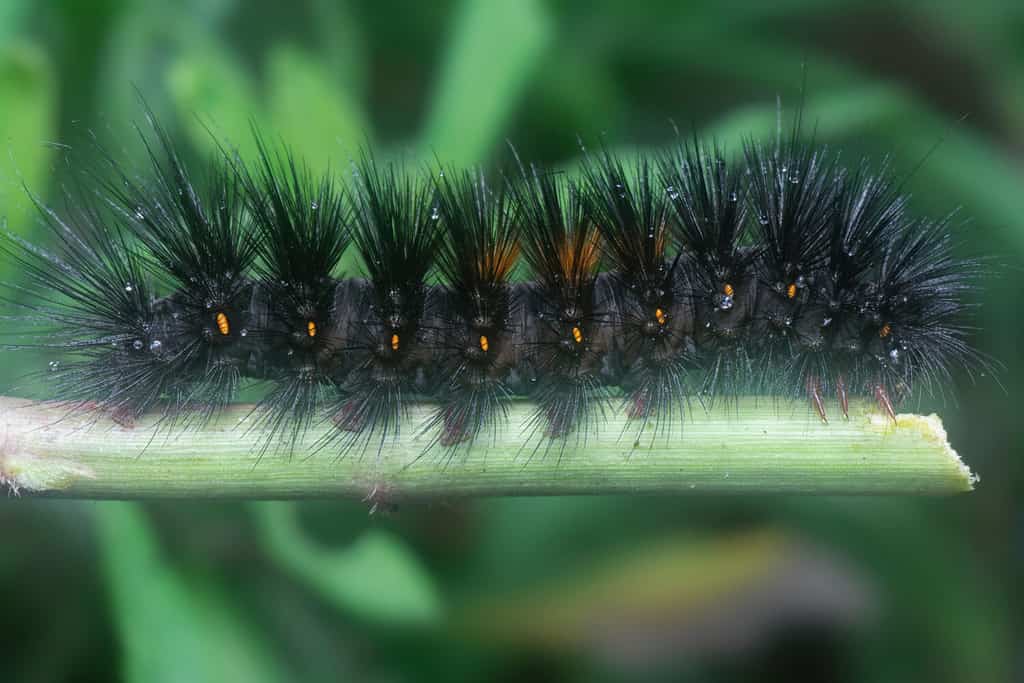
Although covered in black spines, the giant
leopard
moth caterpillar is harmless.
©Young Swee Ming/Shutterstock.com
The giant leopard moth caterpillar is blanketed in black spines. When threatened, it often coils into a ball, adopting a defensive stance typical of the giant leopard moth. They have an appetite for various fruits and leaves, including cherries, dandelions, oranges, violets, and willows.
Even though their spiky appearance might suggest otherwise, these caterpillars are completely harmless.
10. Imperial Moth Caterpillar (Eacles imperialis)
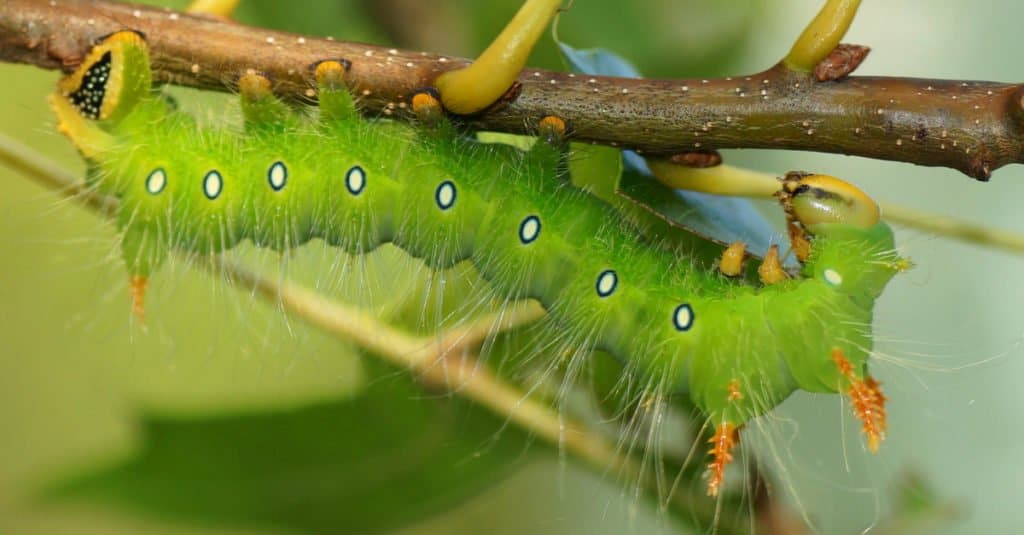
In its caterpillar stage, the imperial moth has stinging hairs.
©Matt Jeppson/Shutterstock.com
Imperial moth caterpillars begin their life as orange, nearly half-inch-long creatures with prominent black spines. As they grow, they transform into hefty worms, ranging from green to brown and sometimes almost black, measuring between three to five inches. Some of the brown variants are highlighted with noticeable orange markings.
When it comes to food, these caterpillars have a range of trees they’ll dine on, but they have a particular fondness for pines, oaks, maples, sassafras, and sweetgum.
Though the name “imperial” might sound regal, one should exercise caution around them. They’re equipped with stinging hairs and sharp barbs that can lead to uncomfortable itching.
11. Io Moth Caterpillar (Automeris io)
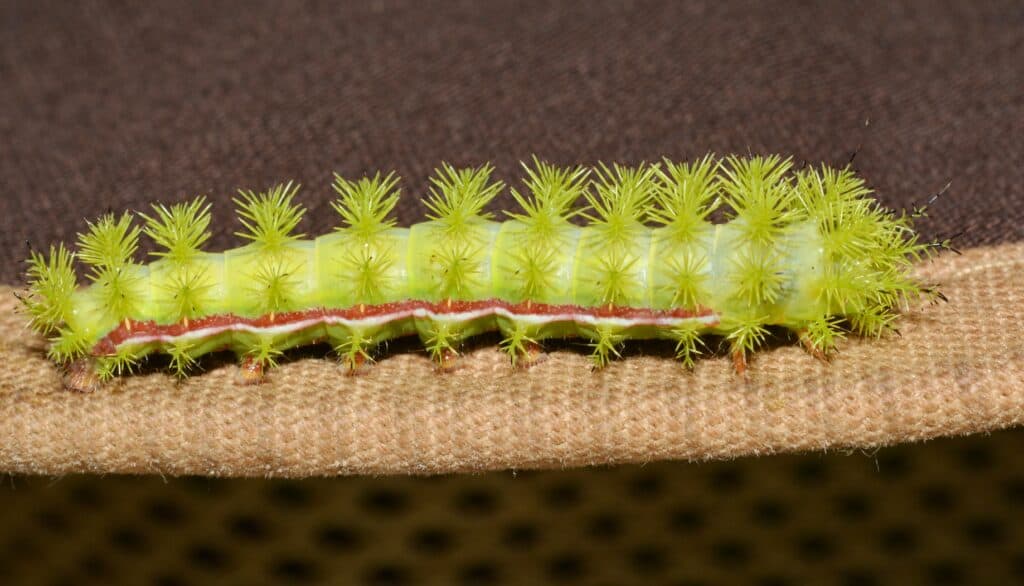
One of the stinging caterpillars in Tennessee is the io moth.
©Andy Reago & Chrissy McClarren / CC BY 2.0 – License
Io moth caterpillars sport a light green hue, adorned with spiky textures and a standout red and white stripe running along their sides. Their bodies are accentuated with green bristles that can sting on contact. These larvae can grow impressively, reaching up to 2.4 inches when fully developed. These caterpillars have a diverse palate, munching on everything from grasses and common plants to shrubs, leafy trees, and even conifers.
Among stinging caterpillars in Tennessee, the io moth’s larvae are notably troublesome. Their bristles are not just for show; they’re linked to venom-filled glands.
12. Large Tolype Moth Caterpillar (Tolype velleda)
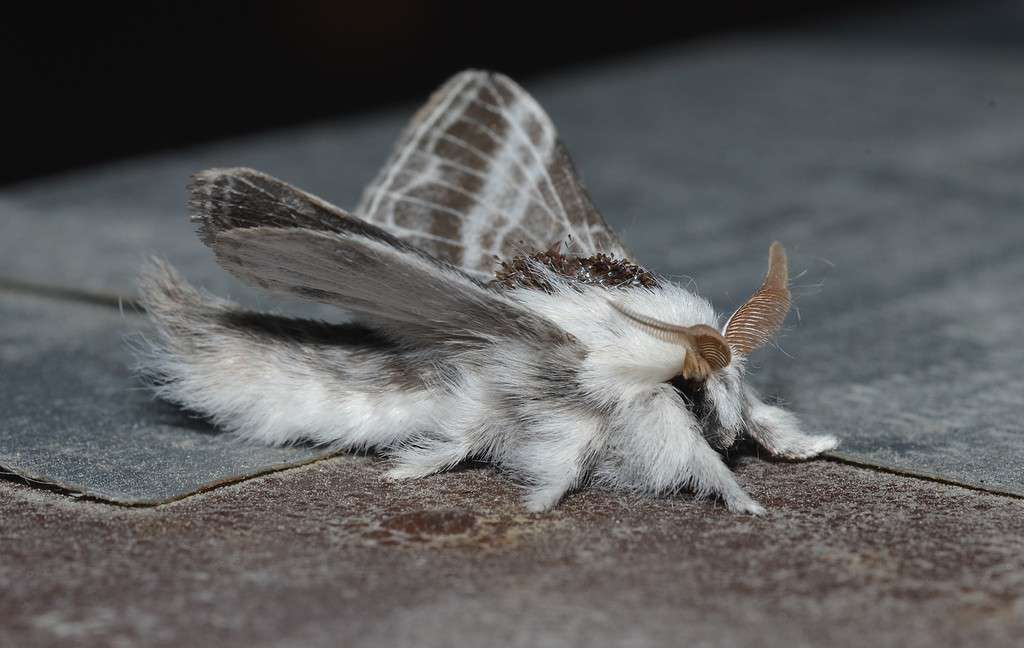
This caterpillar later turns into the large tolype moth.
©Andy Reago & Chrissy McClarren / CC BY 2.0 – License
The tolype or large tolype moth caterpillar has a muted gray shade and is notably fuzzy. As it grows, the flap on its pro legs tends to fade away. These caterpillars are most commonly seen between June and August in Tennessee. They’re often found on ash, plum, birch, apple, oak, and several other broadleaf trees.
These caterpillars also have a taste for various crops, posing challenges for farmers due to the potential damage. They are also poisonous to humans!
13. Luna Moth Caterpillar (Actias luna)
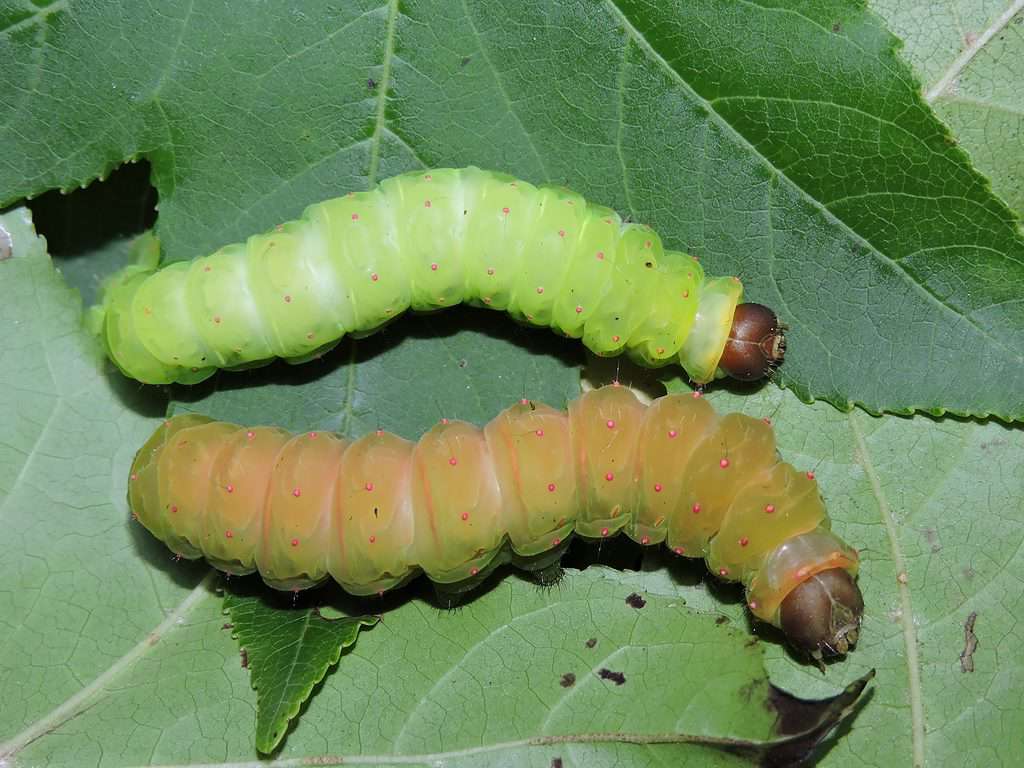
Thankfully, luna moth caterpillars don’t sting!
©TamiG/Shutterstock.com
The luna moth caterpillar, which matures into the iconic green luna moth, showcases a unique grid-like pattern on its green body. This design is punctuated by tiny orange specks on its raised sections. Their bodies, spanning 2 to 2.5 inches, also feature scattered soft bristles. They love to feed on the leaves of hickories, persimmon, sweet gum, and sumacs.
Contrary to popular belief, luna moth caterpillars are not harmful.
14. Monkey Slug Caterpillar (Phobetron hipparchia)
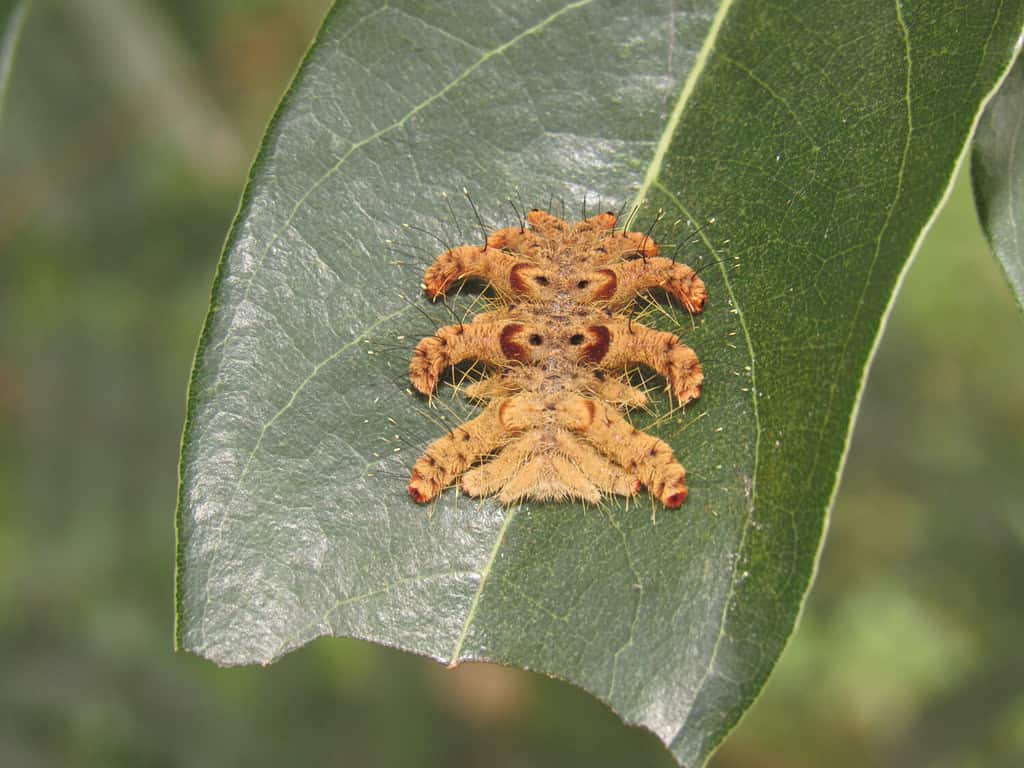
One of the most interesting caterpillars in Tennessee is the monkey slug.
©Fabio Ara/Shutterstock.com
The monkey slug caterpillar stands out with its unique appearance among Tennessee’s caterpillars. With its fourteen hair-covered projections, it could easily be mistaken for an extra-fuzzy spider rather than a caterpillar! It feeds on a diverse range of deciduous trees and shrubs, including apple, ash, and birch.
While the hairs on this caterpillar aren’t venomous, they might cause irritation for those with sensitive skin. So, it’s wise to admire a monkey slug from a distance rather than touch it directly.
15. Pipevine Swallowtail Caterpillar (Battus philenor)
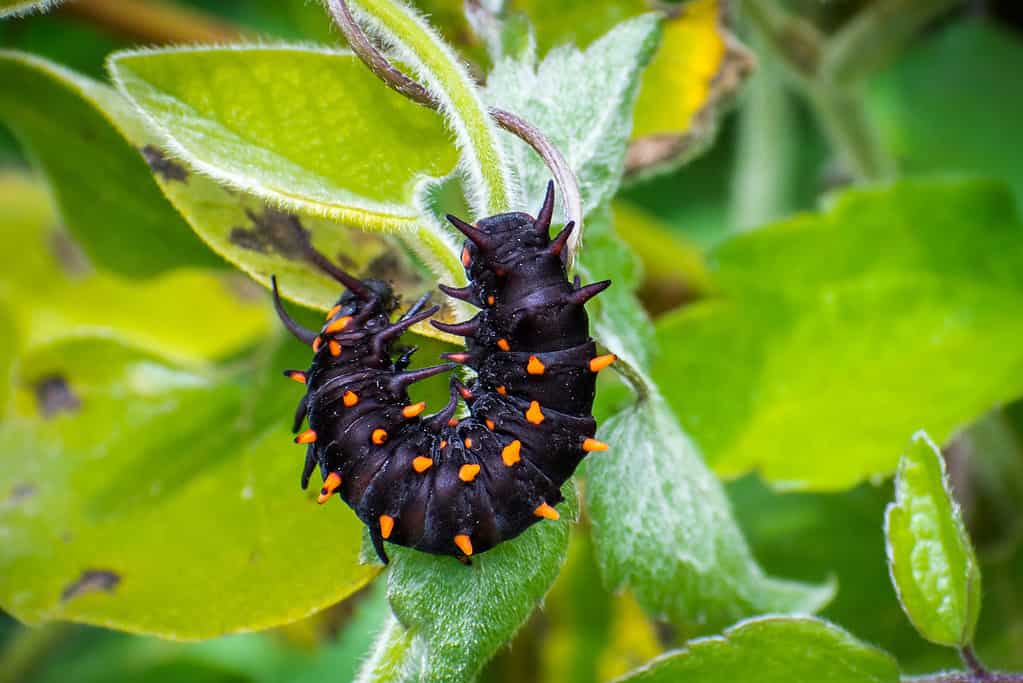
The pipevine swallowtail eats birthworts and Dutchman’s pipes.
©Sundry Photography/Shutterstock.com
The pipevine swallowtail caterpillars are black and adorned with red spikes and spots along their backs, a deterrent to would-be predators. These caterpillars exclusively dine on birthworts and Dutchman’s pipes. If you’re keen on attracting these butterflies, consider adding birthwort vines from local plant nurseries to your garden.
Interestingly, as these caterpillars feed on the pipevine, they consume a harmful compound that makes them toxic.
16. Puss Caterpillar (Megalopyge opercularis)
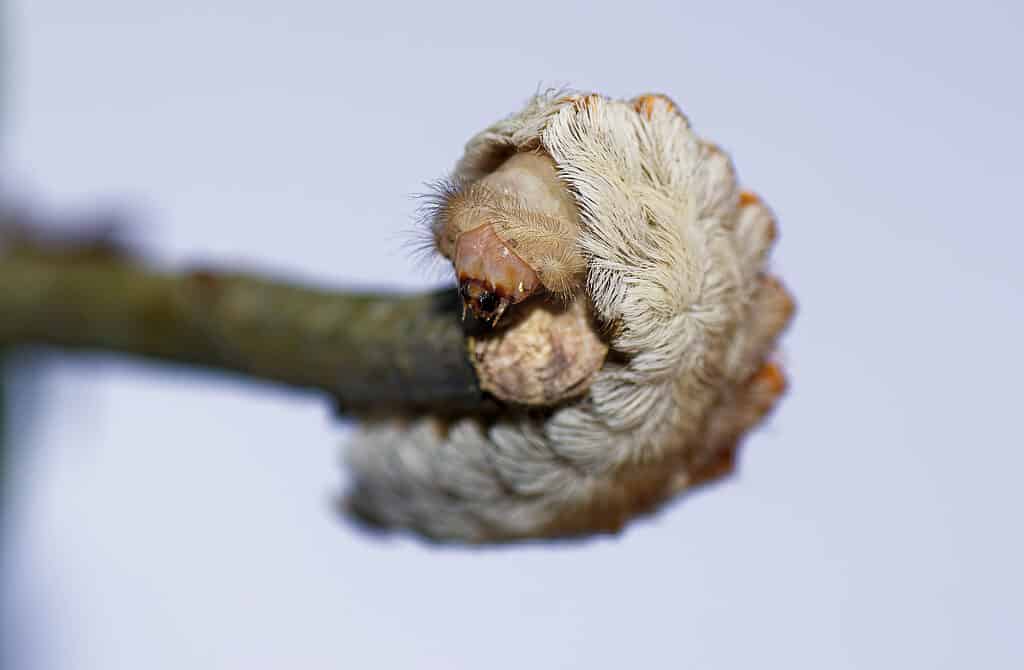
Although it may look furry and inviting, avoid touching the puss caterpillar!
©Chase D’animulls/Shutterstock.com
The puss caterpillar is distinctive with its furry exterior, cloaked in dense tan to pale-gray hairs that thin out towards its tail end. Hidden within its fluffy appearance are short, venom-releasing spines that are a hazard to those who touch them. From an overhead view, its head and tiny legs remain concealed.
They primarily feast on the leaves of trees like poplar, sallow, and willow. Due to their dietary preferences, they’re commonly found in woodlands, parks, or even residential gardens.
Regarded as one of Tennessee’s most toxic caterpillars, the puss caterpillar’s body is lined with venomous bristles. An unfortunate encounter with it can lead to intense pain and persistent blisters.
17. Question Mark Caterpillar (Polygonia interrogationis)
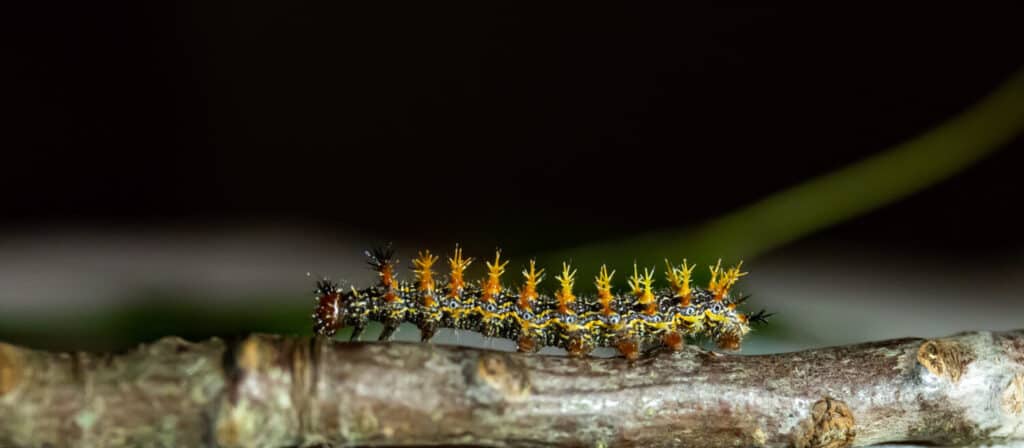
Although they may look dangerous, question mark caterpillars are safe to touch.
©Dank Pics/Shutterstock.com
The question mark caterpillar sports a deep black hue with a contrasting reddish-brown head. Adorning its black body, you’ll find streaks of yellow, orange, or red that extend from head to tail, punctuated by tiny white dots. These caterpillars have a preference for munching on leaves from the American elm, hackberry, hops, stinging nettles, and other similar plants.
Despite their vibrant appearance, they pose no threat.
18. Red Admiral Caterpillar (Vanessa atalanta)
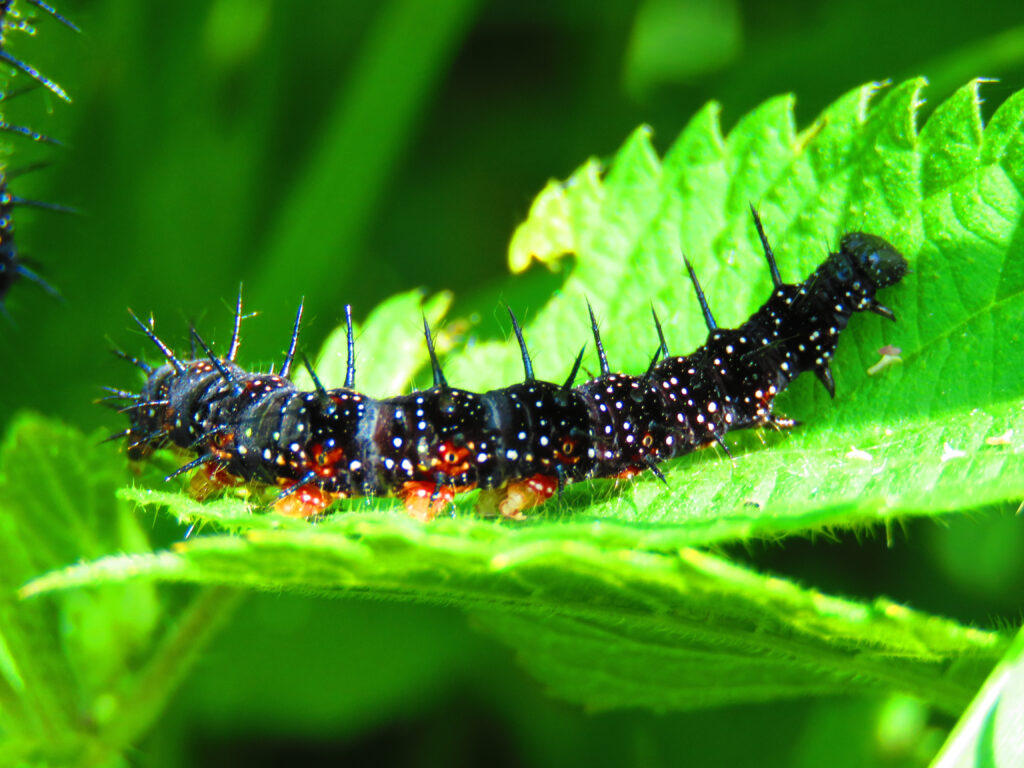
Surprisingly, red admiral caterpillars are not red.
©Przemyslaw Muszynski/Shutterstock.com
Red admiral caterpillars undergo noticeable changes throughout their growth stages. Their colors can range from black and greenish to whitish or brown, adorned with tiny bumps and dark prickles. While red admirals can enter hibernation as adults or during their chrysalis phase, they struggle in freezing climates. These caterpillars have a preference for feasting on plants from the nettle family, Urticaceae.
Despite their spiky appearance suggesting danger, they’re actually harmless and can be safely touched.
19. Saddleback Caterpillar (Acharia stimulea)
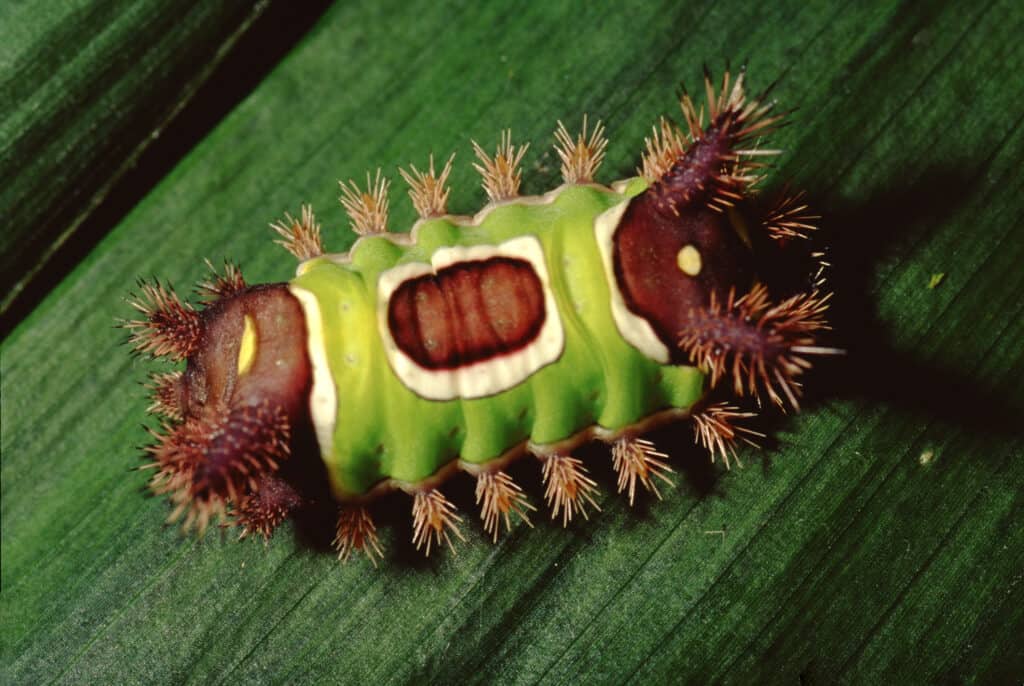
One of the more unique-looking caterpillars in Tennessee is the saddleback caterpillar.
©Liz Weber/Shutterstock.com
Saddleback caterpillars have distinctive markings: brown at both ends with a central brown patch encircled by white on their backs. Two noticeable protrusions are present at the front and back. And, of course, the most notable part of its appearance is its green “saddle”. As larvae, they measure about an inch in length and have a slug-like appearance. Their diet consists of foliage from an array of plants, such as spicebush, dogwoods, and crape myrtle, to name a few.
Approach with caution: these caterpillars are poisonous. Their sting induces immediate pain that can radiate to nearby lymph areas. The accompanying swelling and redness can persist for several days.
20. Smartweed Caterpillar (Acronicta oblinita)
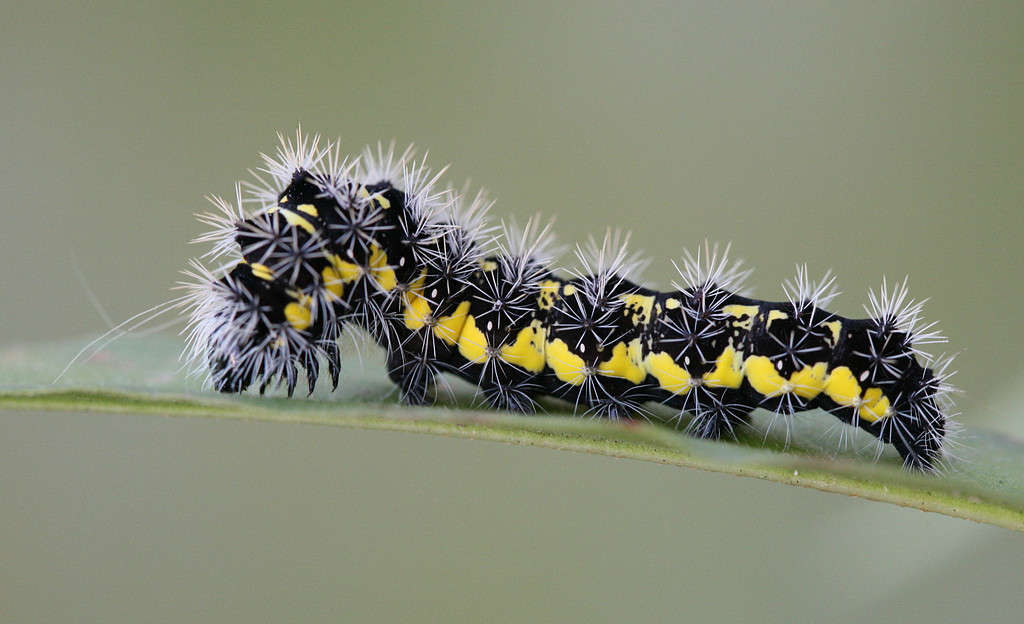
As you might be able to tell, you should avoid touching the smartweed caterpillar in Tennessee!
©Naturalist/iStock via Getty Images
The smartweed caterpillar can grow up to 2 inches and sports vibrant colors with short, prickly hair tufts. While named after a particular plant, they aren’t exclusive to smartweeds. They also munch on various other plants, including leaves from diverse trees and shrubs.
It’s wise to keep a distance as these caterpillars are venomous!
Regions in Tennessee With the Most Caterpillars
Tennessee’s diverse landscapes and climates make it a haven for numerous caterpillar species. From vast forests to city parks, here are the regions and places where you’ll find an abundance of these fascinating creatures:
- The Cherokee National Forest: Spanning over 650,000 acres, this forest provides a mix of habitats, from hardwood forests to meadows, making it a caterpillar paradise.
- The Great Smoky Mountains: Renowned for its biodiversity, the dense forest is perfect for many caterpillar species.
- The Cumberland Plateau: With its unique geological formations and diverse plants, it’s a top destination for caterpillar enthusiasts.
- City parks across Tennessee: City parks, often designed with diverse plantings and maintaining green spaces, become urban refuges for caterpillars. The mixture of native and ornamental plants gives caterpillars a number of feeding options.
Summary of Caterpillars Found in Tennessee
| Caterpillar | Type of Caterpillar | Poisonous? | |
|---|---|---|---|
| 1 | American Dagger Caterpillar | Moth | Yes |
| 2 | American Lappet Moth Caterpillar | Moth | Yes |
| 3 | Army Cutworm Caterpillar | Moth | No |
| 4 | Buck Moth Caterpillar | Moth | Yes |
| 5 | Common Buckeye Caterpillar | Butterfly | No |
| 6 | Eastern Tent Caterpillar | Moth | No |
| 7 | Eastern Tiger Swallowtail Caterpillar | Butterfly | No |
| 8 | Fall Webworm Caterpillar | Moth | No |
| 9 | Giant Leopard Moth Caterpillar | Moth | No |
| 10 | Imperial Moth Caterpillar | Moth | Yes |
| 11 | Io Moth Caterpillar | Moth | Yes |
| 12 | Large Tolype Moth Caterpillar | Moth | Yes |
| 13 | Luna Moth Caterpillar | Moth | No |
| 14 | Monkey Slug Caterpillar | Moth | No |
| 15 | Pipevine Swallowtail Caterpillar | Butterfly | Yes |
| 16 | Puss Caterpillar | Moth | Yes |
| 17 | Question Mark Caterpillar | Butterfly | No |
| 18 | Red Admiral Caterpillar | Butterfly | No |
| 19 | Saddleback Caterpillar | Moth | Yes |
| 20 | Smartweed Caterpillar | Moth | Yes |
The photo featured at the top of this post is © Sundry Photography/Shutterstock.com
Thank you for reading! Have some feedback for us? Contact the AZ Animals editorial team.




